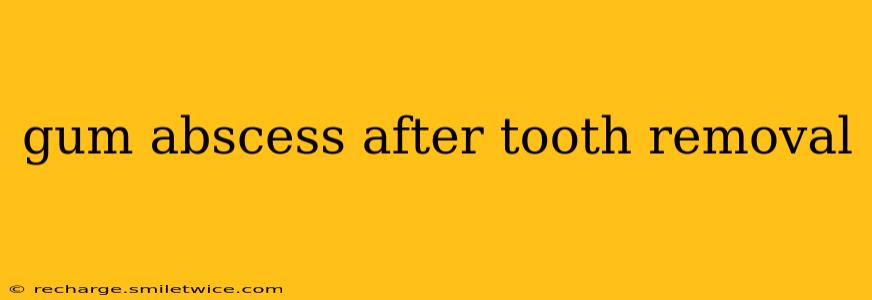A gum abscess after tooth removal, also known as a post-extraction alveolar osteitis, is a painful complication that can occur after a tooth is pulled. While not common, it's crucial to understand its causes, symptoms, and treatment to ensure a swift recovery. This comprehensive guide will cover everything you need to know about this potentially serious issue.
What is a Gum Abscess After Tooth Removal?
A gum abscess after tooth extraction is a localized infection in the gum tissue surrounding the extraction site. It's characterized by a pocket of pus caused by bacteria. This infection can manifest in varying severities, from mild discomfort to a severe, debilitating condition requiring immediate medical attention. The primary cause is often the failure of the blood clot to form properly in the extraction socket, leaving exposed bone and nerves susceptible to infection. This exposed bone is highly sensitive and prone to bacterial invasion.
What Causes a Gum Abscess After Tooth Extraction?
Several factors can contribute to the development of a gum abscess after tooth removal:
- Dry Socket (Alveolar Osteitis): This is the most common cause. A dry socket occurs when the blood clot that normally forms in the extraction site dislodges or fails to form adequately. This exposes the underlying bone and nerve endings, making it vulnerable to infection and causing significant pain.
- Infection: Bacteria from saliva or food particles can enter the extraction site, leading to infection and abscess formation. Poor oral hygiene before and after the extraction significantly increases this risk.
- Residual Root Fragments: If parts of the tooth root remain in the socket after extraction, they can act as a nidus for infection.
- Compromised Immune System: Individuals with weakened immune systems are more susceptible to developing infections, including gum abscesses.
- Smoking: Smoking significantly impairs healing and increases the risk of dry socket and subsequent infection.
What are the Symptoms of a Gum Abscess After Tooth Extraction?
Recognizing the symptoms is crucial for timely treatment. These can include:
- Severe, throbbing pain: This is usually the most prominent symptom, often radiating to other parts of the face.
- Bad taste or odor in the mouth: The pus from the abscess can cause an unpleasant taste and smell.
- Swelling and redness: The gum tissue around the extraction site will likely become swollen and red.
- Fever and chills: In severe cases, a systemic infection can develop, causing fever and chills.
- Pus: You might notice a yellowish or whitish discharge from the extraction site.
- Difficulty opening your mouth (trismus): Severe inflammation can make it difficult to open your mouth fully.
How long does it take for a gum abscess to develop after tooth extraction?
Typically, symptoms of a dry socket and subsequent abscess will appear within a few days after the extraction, usually between 2-5 days. However, it can sometimes take longer, depending on individual healing rates and contributing factors.
Can a gum abscess after tooth extraction heal on its own?
No, a gum abscess will not heal on its own. It requires professional medical intervention to address the infection and promote proper healing. Ignoring the symptoms can lead to serious complications.
What are the treatment options for a gum abscess after tooth extraction?
Treatment typically involves:
- Irrigation and Debridement: The dentist or oral surgeon will clean the extraction site by removing any debris, dead tissue, or remaining root fragments. They will also irrigate the area with a saline solution to flush out bacteria.
- Pain Medication: Over-the-counter or prescription pain relievers can help manage the pain.
- Antibiotics: Antibiotics are often prescribed to fight the infection.
- Packing the Socket: A medicated dressing might be placed in the socket to promote healing and provide pain relief. This dressing needs to be changed regularly.
How to prevent a gum abscess after tooth extraction?
Prevention is key! Follow these tips to minimize the risk:
- Maintain good oral hygiene: Brush and floss regularly, especially before and after your extraction.
- Avoid smoking: Smoking significantly hinders healing and increases the risk of complications.
- Follow your dentist's instructions carefully: Adhere to all post-operative instructions, including medication and activity restrictions.
- Eat soft foods: Avoid hard, crunchy, or chewy foods that could dislodge the blood clot.
- Avoid using straws or spitting: These actions can create suction and dislodge the blood clot.
This information is intended for general knowledge and does not constitute medical advice. Always consult with a dentist or oral surgeon if you suspect you have a gum abscess after tooth extraction. Early diagnosis and treatment are vital to preventing serious complications and ensuring a successful recovery.
